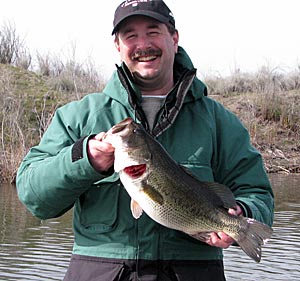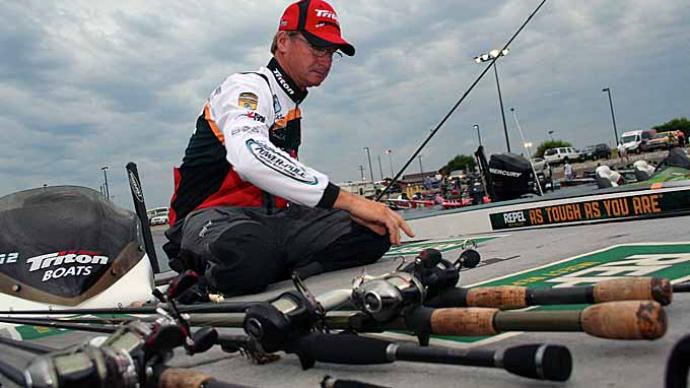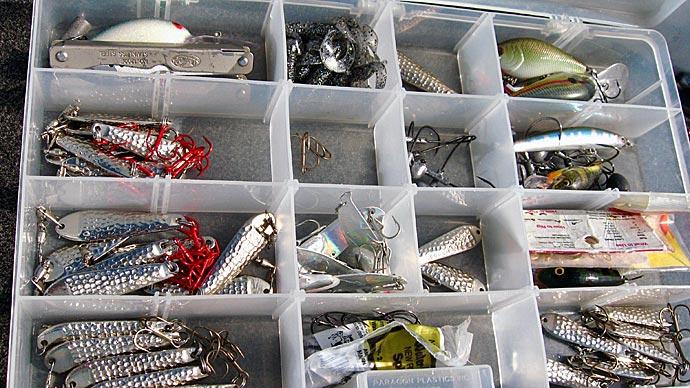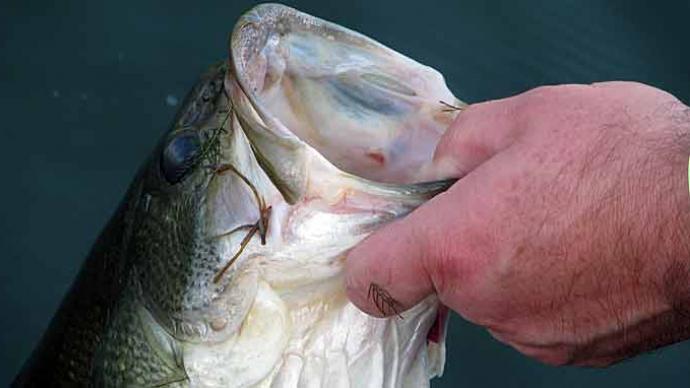
This is one of my favorite times to go bass fishing. There is very little pressure on the lake and you don't have to go very far from the ramp to find a nice deep-water hole. During January, February and early March I concentrate on slabbing for deep-water bass. The slab or jigging spoon is a deadly bait that will catch bass like crazy when worked correctly.
I have talked to a lot of fishermen over the years that have tried this technique and failed so they never tried again. I'm telling you from experience that this is a very easy and productive way to catch bass. I guess these fishermen went out and dropped a slab overboard and expected to just start loading the boat. It is a lot more involved than that. First of all you need to know what to look for. I spend a lot of time searching for the areas I want to try. With our never ending water level fluctuations each winter I have to start over and find new areas. Last winter for example, I found some very good areas and caught bass there every time I went out. These areas held bass for almost two months and then they only moved a couple of hundred yards towards shallower water.
When I start my search for slabbing water I always search for creek channel drop-offs. Often there are hundreds of these types of places, narrowing them down and trying a few is the hard part. When you leave the ramp, you need to have a mindset that you are going to spend a lot of time looking and a little time fishing. I know if you drive for several hundred miles you can't wait to start chunking, but be patient in your search.
Try to concentrate on a small area and really look it over good. I try to find bends in the channels that have at least 25 feet of water on top. My best success has always been on drop-offs from about 25 feet on top to at least 40 to 60 on the down side. If you find such an area that has hydrilla on the top of the drop-off, you have found a real good spot.
My best areas this past winter had grass on top of a 22-foot ledge that dropped into 41 feet of water. My youngest son Randv and I caught a lot of good bass in this area, and all were taken on slabs. We would get right along the edge of the ledge sitting in the deeper water, but only fishing about 10 to 15 feet on the top of the ledge. Moving the boat super slow, we would pitch our slabs out and let them fall into the grass on top. This is the tricky part. Don't let it fall into the grass very far. A 1-ounce piece of lead goes right through the grass and hangs up easily. Just let the slab tick the grass then rip it up and let it fall into the deeper water on freespool, letting the line out fairly fast. Once it hits the bottom in the deeper water I work it with short jerks of the rod tip, following it back down without too much slack line. Many of the strikes occurred just as we ripped the slab from the grass and it started to fall. These strikes can be anything from barely detectable, to rip the rod out of your hands.
This was not a one-time, one-day, blunder. It worked for almost two months with bass up to 9-1/2 pounds being taken in this one spot. I had several other spots that produced just as well. I try to find some spots on both sides of the lake, so no matter which way the wind is blowing I can usually have decent boat control. It's hard to slab when the wind is whipping your boat around. You need complete control to sit on an offshore ledge or channel for any length of time. My Pinpoint sure makes this easier, locked onto a channel and set at creeping speed, I can cover an area thoroughly and always learn something new.
I have tried many different rods over the years, but found that a shorter rod is easier for me to control, you have more leverage with a longer rod, but you don't really need brute strength to get these bass up and moving. My arm tires quickly using a long rod with a long handle. I use a 6-foot rod that is fairly stiff along with 20-pound Trilene Big Game (green). I really like braided line and use it a lot for other types of fishing, but for slabbing I kept losing too many baits.
You can feel every little thing down there, and very easily set the hook into things other than a bass' mouth. I see guys fishing every winter and wonder how their arms can hold up to the constant ripping of the slab, you don't have to move the bait much. I usually lift the rod about two feet. If you go crazy ripping it up and down, the hook will be tangled on the line, or the stripers will eat you up. I have also noticed that stripers and whites like a faster moving slab.
I keep my color selection fairly simple, I use a 1-ounce slab that I make. It's a simple bait that can be bought at almost any tackle store. My primary colors are white and chartreuse. If it's a cloudy day I have had good luck using purple, seems strange but Frank Drury here in Del Rio started doing this years ago, and it does work at times.
I always use a good ball bearing swivel on my slabs. They will twist your line without this. I also use a light wire hook that is very sharp, but will straighten out with the 20-pound line. When you hook a bass on a slab there is simply no reason to try to horse it to the boat. If they break water with this heavy bait slashing around, you will probably lose the fish.
In 40 feet of open water, you just need to set the hook and start slowly working them up. Sometimes they will streak towards the surface and fast reeling is necessary to catch up with them before they can jump. Try holding the rod to the side and even placing the tip in the water if this happens, you don't want them tail-walking. Sometimes they will fight like crazy and other times you will think you have a dink on, only to have it be a 5-pounder. You never know in cold water.
Another deep favorite tactic that worked last year was using a 1-ounce Rat-L-Trap, ripped out of deep grass and allowed to free fall. It proved very effective. I have even pegged a 1/4-ounce slip sinker against the Rat-L- Trap to get it down quicker. This is a big-bass bait. It's amazing how easy they will take this, sometimes the only feeling is a slight tap, almost like a worm strike.
On calm cold days using a wacky worm in deep water can be effective. With two nails pushed into the head of a Zoom Trick worm on 10-pound line you can reach the 30-foot level. But you need to be patient as the strikes are sometimes hard to detect. I have caught bass on a wacky worm in every month of the year here on Amistad. I have a lot of confidence in this rig and know it will produce. The wind is the only reason I don't throw it all the time.
This year I plan on using a drop shot rig to probe these deep drop-off's. I'm going to step down to 6- or 8- pound line and give it a fair chance. I think this rig will become very popular here. I have already had some success with it, but like all new techniques you need to make yourself do it to learn it.
Reading about a new technique is one thing, but sticking to it is the key. I remember fishing in east Texas and everyone talking about the wacky worm. I thought how stupid could this be, and refused to try it. But now, you won't find me without one tied on. The same holds true for slabbing, if you don't try it, or should I say make yourself try it, you will never know that cold, deep bass can be easy to catch. It doesn't have to be deep to produce either. I have caught lots of bass in 15 feet of water on slabs. Find a good channel, drop-off or even a good bluff and give it a try.
Don't bring two or three slabs, because you will lose a few, especially when first starting out. With time you will learn that fish bite on the drop of the lure 95 percent of the time. Any strikes while lifting the bait will usually be a rock or something else connected to the bottom. When you set the hook on an underwater snag, position the boat directly over it and with easy lifts of the rod you can usually pop the bait off the snag. If that doesn't work, the 20-pound line and light hook will save you some money.
And try those big Traps during the cold weather. They don't have to be fished the way you normally fish them. Use the weight of the bait to let it fall or add some weight to it to help it get down faster.




